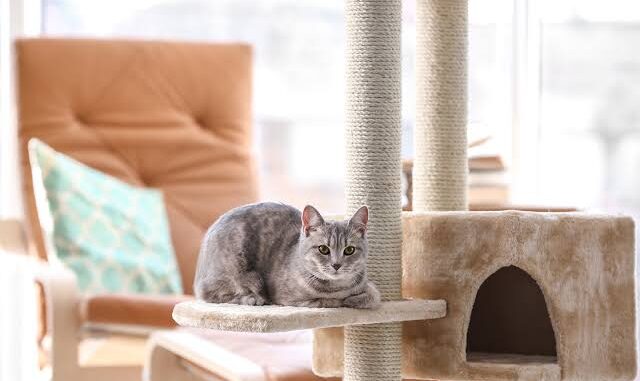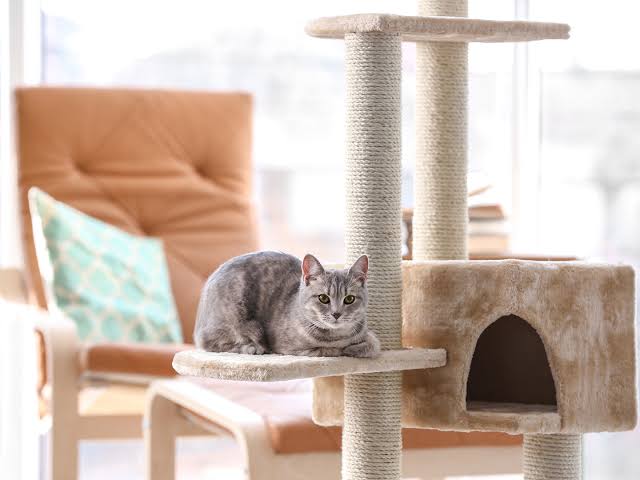
How to Create a Cat-Friendly Home Environment: Cats are territorial, curious, and intelligent creatures that thrive in environments tailored to their natural instincts. Whether you live in a sprawling house or a compact studio apartment, creating a cat-friendly home environment is key to ensuring your feline friend feels secure, stimulated, and well-cared for.

In this guide, we’ll explore how to turn your home into a feline haven with design strategies, behavioral insights, product recommendations, and safety tips. Whether you’re adopting your first kitten or enhancing the space for a long-time companion, this article offers practical, cat-centric solutions.
Understanding Cat Behavior: The Foundation of a Cat-Friendly Home
Before making changes, it helps to understand the core behaviors and instincts that influence how cats interact with their environment:
- Territoriality: Cats need defined spaces where they feel secure.
- Vertical Climbing: Cats instinctively seek high vantage points.
- Scratching: A natural behavior to mark territory and sharpen claws.
- Hiding: Cats retreat to hidden spaces when stressed or tired.
- Hunting: Play and prey-chasing mimic their natural instincts.
- Routine and Scent: Cats rely heavily on scent cues and daily patterns.
Designing your home to meet these needs enhances their mental and physical well-being.
Step-by-Step: Creating a Cat-Friendly Home
1. Provide Vertical Territory
Why it matters: Cats feel safer when they can observe from above. Vertical space reduces stress in multi-cat households and gives a sense of control.
How to implement:
- Install cat shelves or perches near windows.
- Use tall cat trees (6 ft+ recommended for adults).
- Repurpose bookshelves or wardrobes as climbing spaces.
Tip: Place vertical options in social areas and near resting spots.
2. Design Safe Hideaways
Why it matters: Cats need quiet, enclosed areas to retreat when overwhelmed or tired.
How to implement:
- Create cozy nooks using boxes, baskets, or covered beds.
- Use furniture with built-in hideouts (like bench seats with curtains).
- Convert closet space or under-bed areas into soft hideaways.
Pro Tip: Avoid placing hideaways near loud appliances like dishwashers or laundry machines.
3. Scratching Solutions That Save Your Furniture
Why it matters: Scratching is essential for claw health and territory marking.
How to implement:
- Offer varied scratching posts (vertical and horizontal).
- Place scratchers near sleeping areas and doorways (common scratch zones).
- Use materials cats love — sisal, cardboard, and carpet.
Encouragement: Sprinkle catnip or silvervine to make scratchers more enticing.
4. Litter Box Placement & Hygiene
Why it matters: Poor litter box setup can lead to accidents or anxiety.
Best practices:
- 1 litter box per cat + 1 extra (e.g., 2 cats = 3 boxes).
- Place in quiet, low-traffic areas—not next to food or water.
- Scoop at least once daily and change litter weekly.
Avoid: Covered boxes if your cat seems hesitant—some prefer open styles for visibility and scent dispersion.
5. Create Engaging Play Areas
Why it matters: Play prevents boredom, stress, and obesity.
How to implement:
- Rotate interactive toys (feather wands, motorized mice).
- Use puzzle feeders or treat-dispensing balls.
- Set up “hunting zones” with toys placed under rugs or furniture edges.
Pro Tip: Schedule two 15-minute play sessions daily to mimic prey-chasing routines.
6. Design Safe Window Views
Why it matters: Cats are natural observers. Window-watching satisfies curiosity and provides mental stimulation.
Setup ideas:
- Install a cat window perch with suction cups or mounts.
- Create an indoor “catio” or balcony garden (with netting or enclosures).
- Add bird feeders outside windows for “cat TV.”
Important: Ensure all windows are screened and secure to prevent falls or escapes.
7. Use Calming Scents and Pheromones
Why it matters: Cats rely heavily on scent for comfort and communication.
Helpful solutions:
- Use feline pheromone diffusers (like Feliway) in common areas.
- Avoid citrus or vinegar cleaners, which cats dislike.
- Use unscented litter and cleaning products to avoid overwhelming sensitive noses.
8. Optimize Feeding Stations
Best practices:
- Keep food and water away from litter boxes.
- Use wide, shallow bowls to avoid whisker fatigue.
- Try cat fountains to encourage hydration.
Pro Tip: For multi-cat homes, separate feeding stations to avoid resource guarding.
9. Keep Toxic Items Out of Reach
Dangerous to cats:
- Houseplants like lilies, pothos, and philodendrons
- Human medications (Tylenol, ibuprofen)
- Cleaning products (bleach, phenols)
- Essential oils (tea tree, citrus, eucalyptus)
Safe alternatives: Spider plants, wheatgrass, catnip, and cat-safe herbs.
10. Multi-Cat Home Tips
If you have more than one cat, ensure each has individual access to:
- Perches
- Hiding spots
- Litter boxes
- Feeding stations
Watch for signs of tension (staring, blocking, chasing) and provide enrichment that reduces competition, like large cat trees and multiple scratch zones.
READ ALSO: The Advantages of Neutering or Spaying Your Dog
Decor Ideas for Stylish, Cat-Friendly Living
- Use rugs or sisal runners for play and claw traction.
- Choose washable throws or blankets on couches.
- Get pet-safe furniture made from tightly woven fabric (like microfiber).
- Incorporate feline-friendly furniture like hidden litter cabinets or climbing bookshelves.
FAQs
How can I make a small apartment cat-friendly?
Use vertical space! Add wall-mounted shelves, hanging beds, and multi-functional furniture (like benches with storage and hiding spots). Rotate toys regularly and provide window access.
Do indoor cats get bored?
Yes. Boredom can lead to destructive behavior, over-grooming, or lethargy. Regular play, puzzle feeders, window views, and scent stimulation help keep indoor cats mentally fit.
Is it okay to keep cats indoors only?
Absolutely. Indoor cats live longer and avoid dangers like cars, predators, and disease. Just be sure to provide ample enrichment, hiding spaces, and stimulation.
Should I leave music or TV on when I leave?
Yes, especially if your cat is anxious. Soft classical music, nature sounds, or “cat TV” (bird videos) can soothe and entertain.
How can I cat-proof wires and furniture?
- Use cord protectors or wrap wires in spiral covers.
- Spray deterrents like bitter apple near chewed spots.
- Hide cables behind furniture or walls when possible.
What’s the best material for cat furniture?
Look for sturdy, natural materials like wood, sisal, and canvas. Avoid flimsy plastics or thin carpeting that tears easily.
How often should I update or change enrichment items?
Change toys weekly to avoid boredom. Rearranging climbing paths, hiding spots, or scratchers monthly keeps things fresh.
Are cats more comfortable with minimal or cluttered spaces?
Cats prefer organized spaces with defined zones — not cluttered, but not sterile either. Provide cozy areas and hiding spots in multiple rooms.
Can I use aromatherapy or candles in a cat-friendly home?
Use caution. Most essential oils are toxic to cats. Choose unscented or cat-safe products, and ensure good ventilation.
Should I let my cat into every room?
Generally, yes—unless the room is unsafe. Create a consistent environment across rooms and allow free access to preferred spots unless behavior (like spraying) becomes an issue.
Leave a Reply
You must be logged in to post a comment.